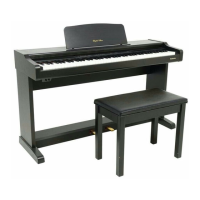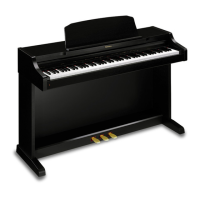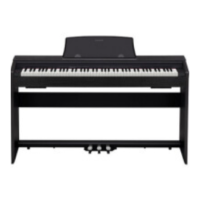
Do you have a question about the Technics SX-PX107 and is the answer not in the manual?
| Type | Digital Piano |
|---|---|
| Effects | Reverb, Chorus |
| Recorder | Yes, 2 tracks |
| Speakers | 2 x 12cm |
| Headphone Jack | Yes |
| MIDI | Yes |
| Touch Sensitivity | 3 levels |
| Keyboard | 88 keys, weighted hammer action |
Risk of electric shock; do not open. Refer servicing to qualified personnel.
Safe use of UK mains plug and fuse replacement procedures.
Ensure voltage adjuster matches local voltage. Use screwdriver for adjustment.
Proper placement for ventilation, heat, humidity, vibration, and dust avoidance.
Safe power cord handling, avoiding metal inside, and internal part warnings.
Handling abnormal operation, cord issues, and basic maintenance procedures.
Steps for connecting power, turning on, setting volume, and playing.
Procedure for listening to Grand Piano demonstration songs.
Playing demos for other sounds and listening to all tunes sequentially.
Selecting sounds and the impact of Touch Response on volume.
Explanation of the sustain and soft pedal operations.
Applying Digital Reverb, Digital Celeste, and adjusting Touch Sensitivity.
Selecting sounds and using sostenuto and soft pedals for PX103/PX107 models.
Adjusting brilliance and setting digital effects for selected sounds.
Introduction to recording and playback using the piano's sequencer.
How to mix two sounds simultaneously and adjust their volume balance.
Adjusting the musical key of the song using the TRANSPOSE buttons.
Capability to adjust the instrument's pitch for ensemble playing.
Adjusting the depth of various digital reverb types.
Customizing the amount of string resonance for piano sounds.
Turning metronome on, adjusting tempo, and setting volume levels.
Adding accents to beats and selecting time signatures for the metronome.
Introduction to storing and playing back performances using the sequencer.
Step-by-step instructions for recording the first track in the sequencer.
Recording the second track while listening to the first track.
Information on note capacity, memory status, and recording limitations.
How to play back recorded tracks and erase specific sequencer tracks.
Procedure for setting functions like tuning, range, and pedal modes.
Resetting all settings to their default status using the INITIAL key.
Explanation of IN, OUT, and THRU MIDI terminals and their uses.
Diagrams illustrating how to connect other MIDI instruments.
How to assign a MIDI CHANNEL number (1-16) to the instrument.
Visual representation of keyboard notes and their corresponding MIDI note numbers.
Setting Multi Timbre for multiple sounds and Local Control for performance routing.
Configuring Omni mode, Program Change transmission, and Transpose data.
Step-by-step guide to setting MIDI functions using MODE SET and keyboard buttons.
How to transmit PROGRAM CHANGE numbers using BANK and NUMBER keys.
Details on connecting pedals, external instruments, amplifiers, and headphones.
Remedies for no sound, blank display, and MIDI local control problems.
Details on memory retention for settings and sequencer data after power off.
Illustrated steps for assembling the piano stand and body securely.
Comparison of keyboard, sounds, effects, connections, power, and dimensions for models.











